The silence fell upon us as soon as we stepped in the shade. Glimmering rays warmed us along the path, mystifying the forest completely. The tall trees bathed in the gentle and caring sun, and the rich secular foliage gave us the feeling of a shelter, a natural refuge from the busy world outside.
***
Sainte-Baume State Forest
Since ancient times, Sainte-Baume has been considered a unique and timeless place. A nemeton to the Celtic tribes, this sacred wood is said to be a portion of heaven descended to Earth, which has served as a place of worship for fertility since time immemorial. The forest was the realm of the deities for centuries during the Roman times, and continued to be a sacred place after Mary Magdalene took refuge in this special area, reason the Sainte-Baume State Forest was labelled as an “Exceptional Forest” in order to contribute to its protection.
***
Chemin des Roys
We left the car in front of Hostellerie, but we could also have used the East Public parking lot. A few more hundred metres walk through the fields, and suddenly we found ourselves enchanted by the beauty of this forest. There are two ways to get to the Sainte-Baume Cave, the left one is Chemin des Roys, and the right one is Chemin du Canapé. We were here to get the first one, and check out why it’s so famous.
The first section is really straight, giving us time to admire the old trees, and the blue sky, but as soon as we took the first turn, a slight ascent began. Here we found the first Oratoire, a little chapel, a place to take a breath and maybe say a prayer. Only four of the seven oratories survived today along the Kings Path.
The gravel on the path didn’t help us much, as the slope got steeper. We had to be careful with every step, as loose rocks came more obviously in our way. But La Source de Nans gave us a little respite (and fresh water) after an abrupt hairpin turn, while the rich green canopy of the surrounding trees gave us a huge impulse to continue walking at a steady pace.
We tried to quickly pass the first group of three people we ever met on the trail after the next Oratoire, and shortly, we took a sight of the Cave’s Basilica. But alas, it looked at such a wrong angle!
***
The Provençal Tradition
In the 1st century in Palestine, the first Christians were victims of persecution. Around the year 43, most of the disciples close to Jesus were driven away from their native land: Mary-Magdalene, the apostle of the resurrection, her brother Lazare, her sister Martha, Mary Jacobe, Mary Salome, Maximin and Sidoine.
It is said that Mary Magdalene (known as Mary of Magdala) would have been delivered from seven demons by Jesus, and became one of his disciples in this way. She was the first one to witness the Resurrection of Christ, three days after his crucifixion.
Crossing the Mediterranean on a frail boat without sail or rudder, they landed on the shores of Provence. According to legend, they were helped by divine providence, and were able to land in Camargue, in Saintes-Maries-de-la-Mer. After preaching in Marseille with her brother Lazare, then in Aix-en-Provence with Maximin, Mary-Magdalene retired to live her last thirty years in prayers in a cave, in the heart of a wild forest that would henceforth be called Sainte Baume (Holy Cave in Provençal dialect).
At the time of her death, Maximin (who had returned to the town that now bears his name) buried the body of Mary-Magdalene in a small oratory. This oratory currently constitutes the crypt of the Basilica. It will also house the tombs of Maximin and Sidoine, who became the first bishops of Aix en Provence.
***
The Cave of Sainte-Baume
After reaching Marseille, Mary Magdalene preferred the solitude of contemplation and found a place by climbing the slopes of the Sainte Baume massif. It is said that for thirty years, the recluse fed on roots and quenched her thirst with water from the sky. In her last years, Mary Magdalene was visited by angels seven times a day, and was either carried to the top of the cliffs to pray there, or rather she was rapt in ecstasy.
Although the cave where Mary Magdalene took refuge became a Christian sanctuary, a place for worship and pilgrimage since the first century, the 13th century was the time when the cave became famous. It is one of the most renowned Christian pilgrimages in the Western world, which would reach its golden age during the reign of Louis XIV, and continues to this day. The name Chemin des Roys was given later, in memory of the many sovereigns and famous people who went on the pilgrimage.
A sanctuary located in the heart of nature, a basilica was installed within Sainte-Baume Cave, where some of the relics of Holy Mary Magdalene are. A place where Christians or curious people go, it is a site of wonders, of tears, or contemplation.
The sanctuary is a cave which can accommodate up to 1000 people, and which is accessed by a staircase of 150 steps. A very beautiful reliquary shelters part of the saint’s remains, while her skull is exposed in the crypt of the basilica of St Maximin in the town.
Today, the basilica from the cave is under Dominican monks’ care. A place to take a break from the sinuous trail, a place to say a prayer, or to admire a panoramic view of the valley below.
***
Saint-Maximin-la-Sainte-Baume
Saint-Maximin-la-Sainte-Baume is steeped in history. The town is located 40 km east of Aix-en-Provence, lying at the foot of the Sainte-Baume mountains, which is the Provençal equivalent of the Holy Cave mountains.
In December 1279, Charles II of Anjou, Count of Provence unearthed the tomb of Mary-Magdalene, finding her holy body. He undertook the construction of the basilica of Saint-Maximin-la-Sainte-Baume, today considered the “Third tomb of Christianity”, in order to lock and preserve the relics of the Saint.
Dominating the city, and one of the main attractions in the city, the Sainte Mary Magdalene Basilica is the largest Gothic edifice in Provence. Inside you can see a Gallo-Roman crypt from the 6th century, Sainte Mary’s sarcophagus, the relics (her skull) as well as several works of art, such the big 18th century organ, the choir and its 94 stalls, the pulpit from the middle of the nave decorated with an image of Mary Magdalene in ecstasy.


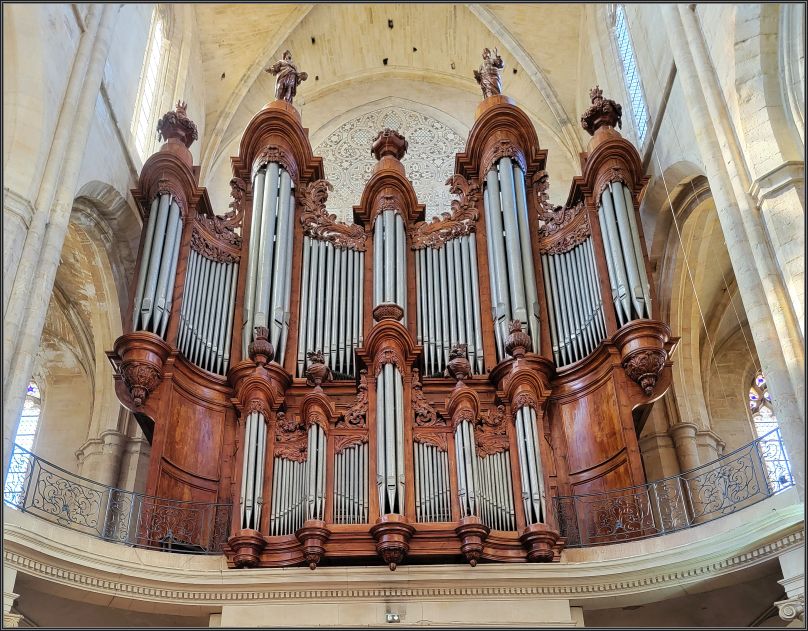



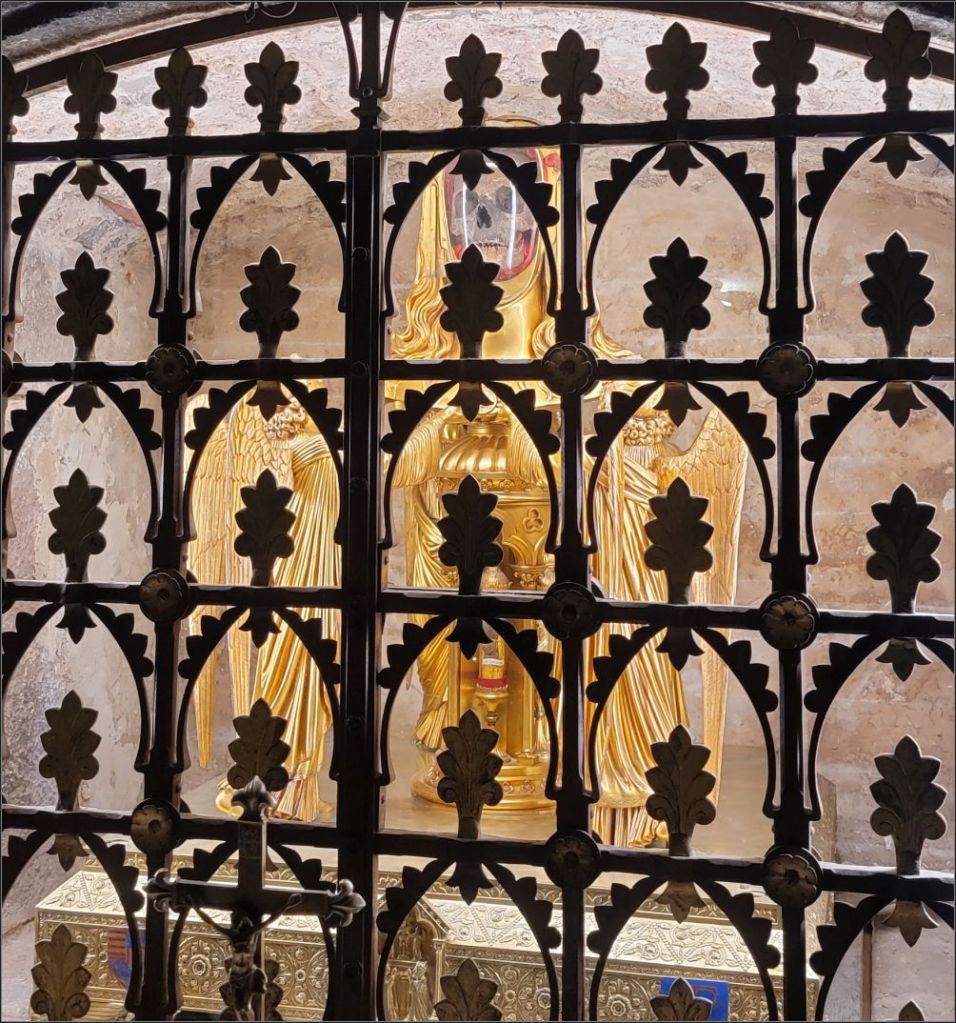
***
Chapel of Saint-Pilon
Part of a hiking circuit, Sainte-Baume Mountain’s ridge offers stunning views over the plains of Aix, and Var, and so we continued our hike, up to the Chapelle du Saint-Pilon.
The canopy of trees provided us a perfect cover on the path, while the sun was still shining across the sunny sky, but as soon as the forest ended, we were faced with a steep climb, the final stretch to the top of the peak. The trail became steeper, and the rocks much sharper. We had to watch and step carefully around the assorted rocks, so we wouldn’t topple over and twist our ankles. In a way, it felt a bit like an obstacle course of all kinds of sharp rocks. Towards the end of the slope, when we were hoping to reach the top, we only faced with another narrow stretch of the trail. This was not for the faint of heart, so I kept looking down the path, and not over the edge.
But despite our tottering steps, we eventually reached the top, being rewarded with an amazing view of the valley below. We followed the path to the west side of the massif, and although the rocky outcrops changed the look, we still had to be careful going around the large and jagged rocks that poke their heads out, in front of us.
The wind picked up, strong and wild, to our surprise. I was expecting to see the chapel soon enough, but there was nothing to see in the distance. A couple of guys hiking the entire length of the cliff confirmed we are in the right direction, but nothing we could see even after walking few more hundred of metres. Although the map said it was about 400 metres, we probably had a bit more than 1 km walking on top of the plateau. But we didn’t mind. The harsh, yet the gorgeous scenery was the perfect setting for a different kind of hike, despite the wild wind blowing up in our face. The rim of the cliff offered a completely different landscape until, finally, we found a nice and very simple chapel at the top of the “pilon”, a spiritual place and a hiking destination for many.
The chapel of Saint-Pilon is a very popular destination. Either as a place of pilgrimage, or a crossing point for hikers, this is part of the sanctuary dedicated to Mary Magdalene. According to tradition, Saint Mary Magdalene came seven times a day to pray on this high place, carried by angels who brought her by air from the cave, where she was living as a hermit. The chapel is very small and has a barred door, we could take a look through and see a statue of the saint.
Between the sky and the land, at a bit over 1,000 metres, the massif of Sainte-Baume is about 12 km long. With steep slopes over 300 metres, the ridge offers splendid climbing and hiking routes, very popular in this area. If you are looking for a dramatic scenery and a place to capture picturesque sunsets, this might be the place to wait for the sun to set over the horizon. But we didn’t want to get trapped around these rocky paths on our way out.
We slowly made our way down the hill towards the town, almost in disbelief of the beauty of these rolling hills. We wanted to descend on Chemin du Canapé (since we ascended on Chemin des Roys), but excited as we were, we missed the junction, ending up going down on the same path as we went up.
***
Tip(s) of the day:
* Although the forest offers a lot of shade, Provence is one of the sunniest region in France, don’t forget your water, hat and sunscreen;
*The Cave of Sainte-Baume is in Dominican brothers care since 1295, with some exceptions; The Hostellerie de la Sainte-Baume is a religious house run by Dominican brothers as well. You can find accommodation at the house, for more information you can read here. You can use the facilities, for free, however it is advisable to carry toilet paper with you (like anywhere else throughout Provence);
*I would rate this out and back 6.0 km trail as moderate, overall. The only difficult section would be the steep segments close to the top, and the loose rocks along the way. It took us about 2.5 hours in total from the Hostellerie’s parking lot (breaks included);
*Sturdy footwear is recommended as the loose rocks are a bit of a challenge;
*Opening hours of Cave’s Basilica is 8:30 and to 5 pm during the winter time, and 7:30 am to 6:30 pm during the summer time, and it is free to visit;
*Opening hours of Basilica of Ste Mary Magdalene (including the crypt) from town is every day from 8am to 7:15 pm, also free.
~ visited in September 2022





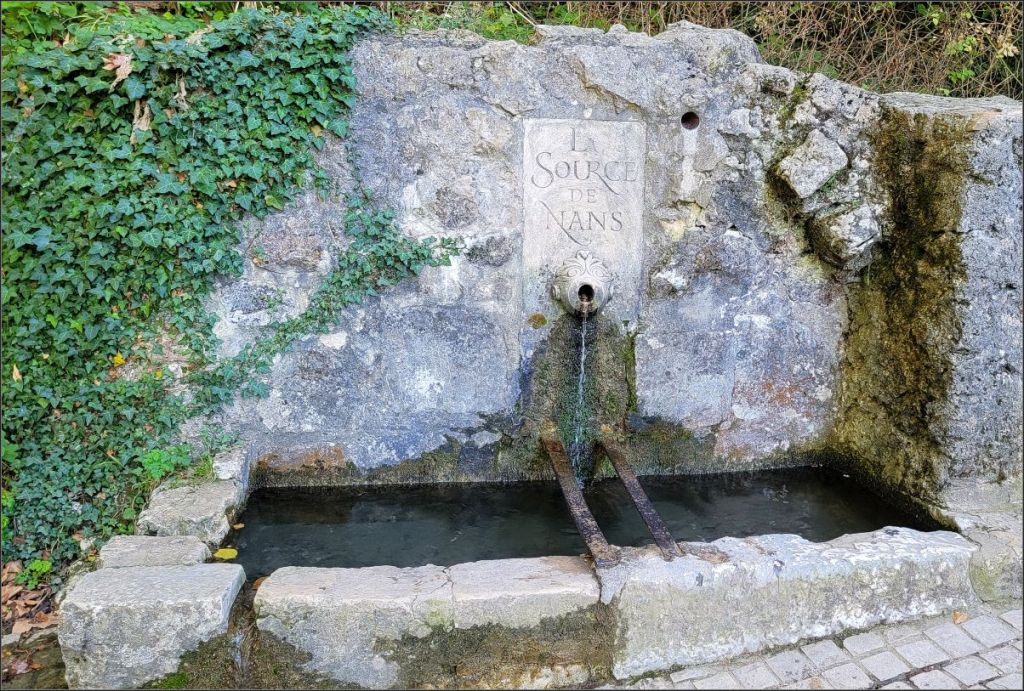

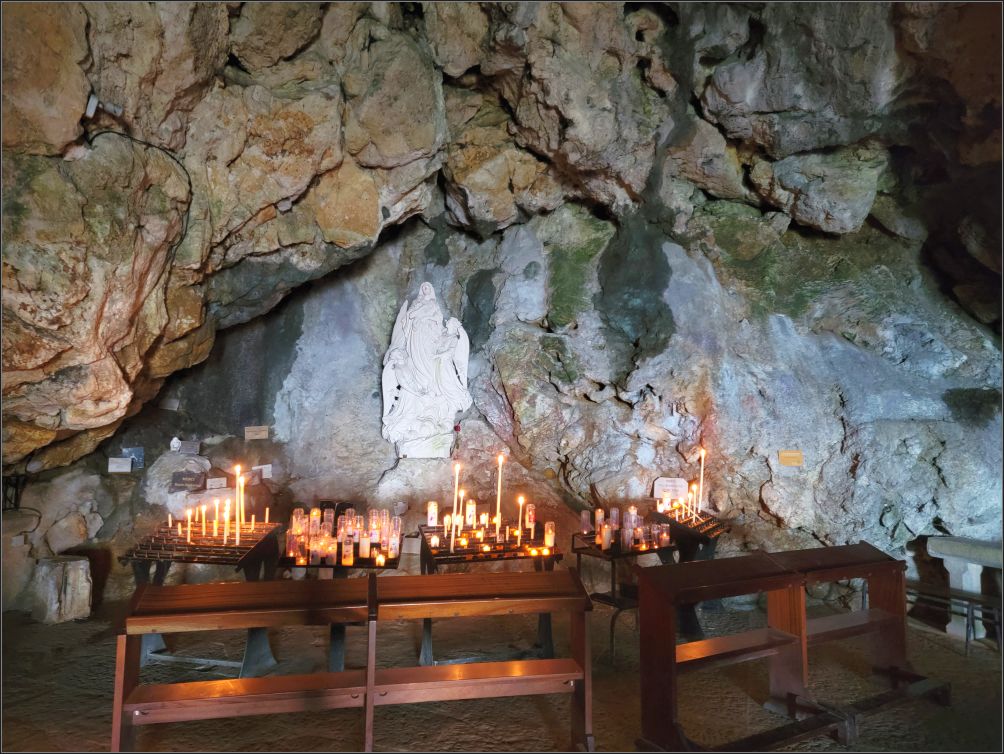
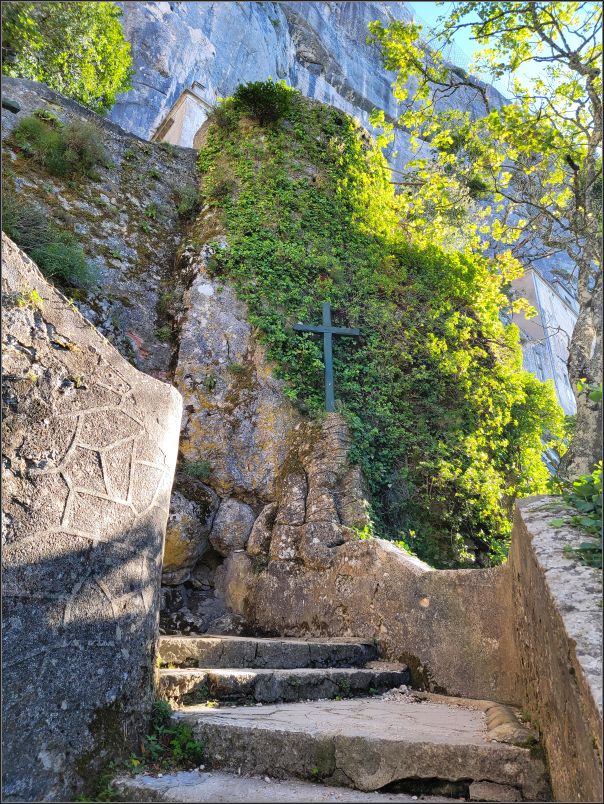










Wow! We haven’t walked in that area. Sainte Mary Magdalene Basilica was so amazing. This cave was historic. Thanks Anita
LikeLiked by 1 person
That area was new to us as well. Thank you, Anita for joining our walk🙂
LikeLike
That looks like an amazing walk with history Christie. Provence has so many nice walks and views, but you are right, never underestimate the sun. I recall how hot it was on Nietzsche’s Path at Eze and we were walking down. Thanks for sharing. Allan
LikeLiked by 1 person
So much history at every turn, in Provence as well as entire Europe. Eze is on our list, next time in France!
LikeLiked by 1 person
When you are there, hike Nietzsche’s Path down from Èze le Village to Èze sur Mer. Down is better than up as the views are spectacular. Cheers. Allan
LikeLiked by 1 person
Thank you for the tip, we will😊
LikeLiked by 1 person
What a beautiful hike. The scenery alone would be worth it but with so much history in the area too. It didn’t look very busy either which is nice. Maggie
LikeLiked by 1 person
I’m not sure how busy is this area in other seasons, but in late September we enjoyed very much our solitary walk, absorbing all the surrounding energy, just for ourselves🙂
LikeLiked by 1 person
Looks like an incredibly scenic hike and a great way to learn more about some history along the way. I love the panoramic view of the valley below.
LikeLiked by 1 person
Indeed, we were rewarded with amazing views from the top; everything looked so green in Provence, and not only here. History is always a bonus!
LikeLiked by 1 person
Quite the hike, Christie. It does look like a beautiful area. I was amused by the shadow photo of the two of you holding hands. Peggy and I often walk the same way if the trail permits it.:) –Curt
LikeLiked by 1 person
Thank you🙂 We found a little section where we could do that, most of the trail was too tricky lol
LikeLike
One of those watch where you are putting your foot with each step kind of trails. 🙂 I’ve been on many over the years!
LikeLiked by 1 person
What a beautiful hike to such intriguing places. Thank you for sharing your experience with us.
LikeLiked by 1 person
Right, these are very intriguing places. Now, that I think of, I’m not quite sure how they came up on our route – and we were not yet aware how beautiful the panoramic views from top would be. Thank you for coming along🙂
LikeLiked by 1 person
Wow, fabulous scenery and a fascinating walk! I was especially interested to read about the town of Saint Maximin as the French footballer of that name, Allain Saint Maximin, plays for the team I support, Newcastle United. I hadn’t mean aware of the background to his name.
LikeLiked by 1 person
I’ve heard of many places being named after a saint, but never a person, this is a very intriguing name..
LikeLiked by 1 person
And I just checked if he was born in or near that town but no, he’s from a Paris suburb: https://en.wikipedia.org/wiki/Allan_Saint-Maximin
LikeLiked by 1 person
Funny as it is, there is another town Saint-Maximin in the suburbs of Paris.. so many “saints” around hahahah
LikeLiked by 1 person
I guess he’s a popular saint in France because of his connection to the country!
LikeLiked by 1 person
A special place to walk, Christie. I knew little about it until I read your post. Many thanks for sharing.
LikeLiked by 1 person
Indeed, this walk was one of a kind. We were not really aware that this kind of history exist in Provence. No wonder why so many French towns (even here, in Canada – in the province of Quebec) are named after different saints.
LikeLike
so so lovely ❤
LikeLiked by 1 person
Thank you for stopping by🤗
LikeLiked by 1 person
My pleasure 😇
LikeLiked by 1 person
Your beautifully written first paragraph drew me in…
LikeLiked by 1 person
Thank you so much, I really appreciate! xx
LikeLiked by 1 person
Hi. Thanks for the tour. I enjoyed it a lot. Neil S.
LikeLiked by 1 person
Thank you, Neil for coming along!
Have a beautiful day, Christie
LikeLiked by 1 person
This is impressive, Christie ! I was only in the main basilica, 2 years ago, thank you for the information about the trail ! The pictures are stunning, and the description is beautifully poetic. Happy Easter, or Zi de Florii binecuvântată ! Cu mult drag, Diana
LikeLiked by 1 person
Sarbatori Pascale binecuvantate! Hristos a Inviat!
xoxo
LikeLike
SOOO beautiful!
LikeLiked by 1 person
Thank you!! xoxo
LikeLiked by 1 person
My pleasure
LikeLiked by 1 person
Wow, Christie! This pilgrimage looks wonderful and your photos are lovely. So much history to explore on this journey.
LikeLiked by 1 person
Thank you so much Nilla, for stopping by. There is always something to discover🙂
Cheers, xx
LikeLike
it is really a sort of fantasy forest isn’t it, with many secrets hidden inside! Thanks for sharing!
LikeLiked by 1 person
Indeed, it was an interesting and peaceful walk. The forest goes off the beaten path, so we really enjoyed the quietness and the surrounding energy.
LikeLike